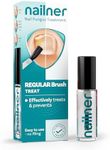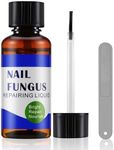Buying Guide for the Best Toenail Fungus Treatments
When choosing a toenail fungus treatment, it's important to consider the severity of the infection, your lifestyle, and any potential allergies or sensitivities you may have. Toenail fungus can be stubborn and may require a combination of treatments for effective results. Understanding the different types of treatments and their key specifications can help you make an informed decision that best suits your needs. Always consult with a healthcare professional if you are unsure about the best treatment for your condition.Type of TreatmentToenail fungus treatments come in various forms, including topical solutions, oral medications, and laser treatments. Topical solutions are applied directly to the nail and are best for mild to moderate infections. Oral medications are systemic and can be more effective for severe infections but may have more side effects. Laser treatments are a newer option that uses light to kill the fungus and are typically used for stubborn cases. Consider the severity of your infection and your comfort with each treatment type when making a decision.
Active IngredientsThe active ingredients in toenail fungus treatments are crucial as they determine the treatment's effectiveness. Common active ingredients include antifungal agents like terbinafine, clotrimazole, and ciclopirox. These ingredients work by inhibiting the growth of the fungus. When choosing a treatment, look for one with an active ingredient that is known to be effective against the type of fungus you have. If you have any allergies, ensure the product does not contain any allergens.
Application MethodThe method of application can affect how convenient and effective a treatment is for you. Topical treatments may come as creams, ointments, or nail lacquers, each requiring different application techniques. Oral medications are taken as pills, which may be easier for some but require adherence to a schedule. Laser treatments are performed in a clinical setting and may require multiple sessions. Consider your lifestyle and how much time you can dedicate to treatment when choosing the application method.
Treatment DurationThe duration of treatment can vary significantly depending on the type of treatment and the severity of the infection. Topical treatments may need to be applied daily for several months, while oral medications might be taken for a few weeks to months. Laser treatments may require several sessions over a few months. It's important to choose a treatment duration that you can commit to, as incomplete treatment can lead to recurrence of the infection.
Side EffectsAll treatments can have potential side effects, which can range from mild to severe. Topical treatments may cause skin irritation or redness, while oral medications can have more systemic side effects like liver damage or gastrointestinal issues. Laser treatments are generally considered safe but can cause temporary discomfort. Consider your health history and any potential risks when evaluating side effects, and consult with a healthcare professional if you have concerns.
















